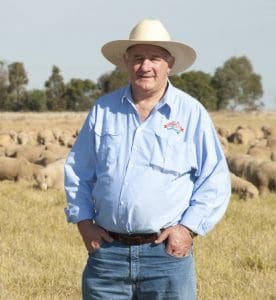
SCA president Jeff Murray
AUSTRALIA’S leading sheep meat producer body will next week consider seeking a change to the AUS-MEAT lamb language to align with New Zealand’s definition, which includes lambs who have erupted their first permanent incisors.
Australia’s AUS-MEAT language currently defines lamb as a female, castrated or entire male up to 12 months of age with no erupted permanent incisor teeth, whereas New Zealand defines lamb as a sheep under 12 months of age or which does not have any permanent incisor teeth in wear.
“We’ve had a report that was quite favourable towards going towards the New Zealand model and it now has to go to our board for consideration,” Sheepmeat Council of Australia president Jeff Murray said.
“Holmes Sackett were commissioned to do a report on it and our market access people have looked at it and it will now go to our board meeting in Dubbo next week,” he said.
“We would be looking to go to the New Zealand model … as soon as the first teeth that is cut meets the pad, they would be hoggets.
“It’s a subjective model of course, the same as the loss of the tooth is, but it just gives producers that extra two or three weeks to get lambs away if they are on the point of cutting their teeth,” Mr Murray said.
Click here to get the latest Sheep Central story links sent to your email inbox.
Lamb definition change not a ‘fait accompli’
The Sheepmeat Council of Australia meets in Dubbo early next week, when it will consider the Holmes Sackett report. Mr Murray confirmed that the SCA supported a transition to the New Zealand lamb definition model.
“All this has to be confirmed by our board; it is not a fait accompli at this stage,” Mr Murray said.
“There is quite a bit of work that would need to be done around the AUS-MEAT table to ensure that it does change.
“It is not going to happen overnight, even when the sheepmeat council ticks off on it.”
But he said all the state farming organisations have representatives on the SFA “so that’s where it will be discussed and finalised.”
The proposed definition change would only mean a 2-3 week extension to the time at which lambs became hoggets, Mr Murray said.
“It is not a big expansion to the time frame, it is not going to make lambs any older, no more than three weeks.”
Mr Murray said the original motion to change the definition came from WA Farmers and the Pastoralists’ and Graziers Association also supports it. He said the Western Australian Meat Industry Authority was very strict on compliance around the current language and many WA lambs were downgraded to hogget at this time of the year.
However, WA with its small domestic market for lamb was operating in competition with its lamb against the New Zealand product, he said. A lamb definition change would also give WA producers more time to finish lambs in feedlots when pasture dries off.
“We haven’t got Sydney and Melbourne on our doorstep to we are in direct competition with New Zealand in the world market and all we are looking for is to get to an even footing with them.”
Nine-year battle to change lamb definition

Sheep meat exporter Roger Fletcher
Fletcher International Exports owner Roger Fletcher said he had been fighting for nine years to change Australia’s lamb definition.
“The beneficiary will be the farmer, because he then has confidence to feedlot lambs or put them on a crop and not be worried about them cutting their teeth.
“This way he has a two-week window and he can have confidence to buy lambs he shouldn’t be buying.”
Bringing Australia’s lamb definition in line with New Zealand would also mean a better quality product for the consumer, by avoiding the sale and processing of sub-standard lambs not on a rising plane of nutrition, he said.
“We are looking to keep farmers in the industry getting better returns and the second one is getting a better product.”
It would also help make Australian lamb more competitive with New Zealand lamb overseas.
“The loser at present is Western Australia, because they lamb at period of the year and then you end up with virtually no lambs because non-one is game to put them in a feedlot, because everyone is afraid they going to cut their teeth, so they won’t finish them.”



It’s bizarre to hear Roger Fletcher only concerned about farmers profitability. No mention of the need to have year-round supply at their abattoirs. If meaningful out-of-season incentives were created it might be profitable for producers to change their production systems. Making the definition of lamb subjective only opens the door for poor industry practices and makes policing of standards hopeless. The lamb industry would be far better off investing in decent growth genetics and production systems that facilitate lambs reaching slaughter weights while they’re still lambs not hoggets. This move will only penalise those of us who have done so, for the benefit of the processing sector. If it is such an issue, put some effort into developing a hogget market instead of compromising a lamb market that is in no way broken.